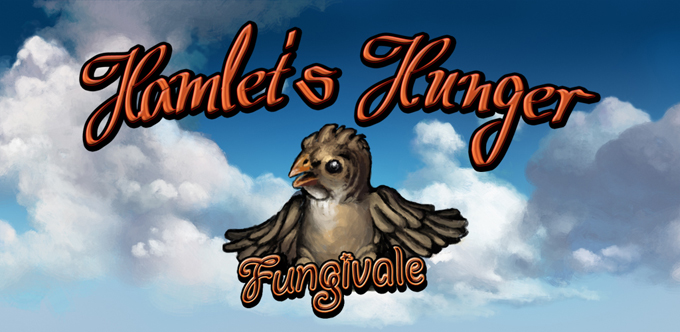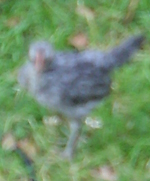Hamlet's Hunger
| What is it? |
Hamlet's Hunger is a mobile clicker game I did the graphics for, and published with my fellows at Keito. Teemu, our scripting master had a mechanics engine built for his minigame idea, but he needed a graphical layout. The basic gist was that balls roll from the top of the screen, and you have to click certain colored balls before they reach the bottom of the screen, or you will lose points. Clicking the right colored balls gives you points, and at certain intervals the color you have to click changes.
I had an idea of a game where you have to feed a demanding little rooster with insects who run across the screen. He would want a different insect whenever he crows out loud. I pitched the idea, and we decided to go with it. The game mechanic is a bit challenging but a fun one regardless. Hamlet's Hunger is free to play and available both for iOS and Android devices. Try it out!

| To be, or not to be? |
The story of Hamlet's Hunger began in the summer of year 2009. At the time my mother managed a small pack of chickens (and still does as I write this). Sometimes when hens lay eggs, they for reasons unknown abandon the batch (typically the farmer steals the eggs before the hen starts to brood). One such rejected batch was found and placed into a heat box, so that they may hatch regardless. The batch yielded only one live chick, who we named 'Hamlet'. He was the only one of his litter, none of his siblings made it - in fact, I remember a gruesome scene of one such chick who couldn't muster the vigor to break his/her shell, and died. This is not uncommon with chickens.
Anyhow, Hamlet made it and instantly became our little darling! He was so innocent and sweet! He was rather unlike any chicken I had seen. Since he had born alone and abandoned by his mother, he had grown attached to us (and in particular, our hands/palms). He would tweet with such pitiable manner when we tried to leave the room where his terrarium was that we didn't have the heart to leave him alone, and often stayed for hours to pet him (yes, he actually liked petting! He even pushed his stupid little chickenhead against my finger when I petted him!)
Once, we found Hamlet tweeting in his most sad and distressed tone when we were away for a couple of days (I lived some 50km from my mother's at the time and didn't visit too much, but it was summer so more often than usually). He was covered in black smudge - he had in his plight devoured too much of the coal left for him (young chickenlings have to have some coal to eat, I'm unsure why). We washed him gently and watched in amusement as he proceeded to shit out jet black stool for the next hour. Hamlet liked to sit on top of our heads, amidst our hair, and he never even once shat on anyone's head, even though chickens are notorious for doing their business just about anywhere. He would sit calmly on your head and survey the surroundings from his high vantage point.
Hamlet loved eating insects, and he would have eaten them all had he the means. Often when a fly entered his terrarium, he would run after it frantically but hopelessly clumsily, so we resorted to catching the fly for him and feeding him. We would run after flies in the yard to take to Hamlet, who would reward us with tweetings filled with gratitude and demands for more to fill his miniscule belly!
My mother decided that Hamlet would become the next rooster of her henhouse. You have to change the rooster occasionally to avoid genetic degeneration, and Hamlet was coincidentally from a batch of eggs gotten from another farmer, so he wasn't related to the chickens of the yard; he'd make a fine rooster...
... Only fate would have it otherwise. One night, when I was away in the city where I lived, some predator, against all odds, made it's way into the cage of Hamlet and made short work of him. He had just recently been moved from the terrarium to a cage of his own in the yard. He couldn't be put in with the other chickens in the henhouse just yet, since he was so young and vulnerable - chickens can be mean as hell to eachother, especially if you're smaller and weaker.
 I don't think I've felt often such anger which I felt that day when my mother called
me to inform of Hamlet's grim fate. To imagine that sweetest of
chickens having to face such terror, such horror before being eaten
alive, it was much to bear for me. If I had gotten my hands on that beast who savaged my
little Hamlet, I would have snapped its neck like a twig. I realized
that day how brutal and unrelenting nature truly is. We, as humans, are
the only ones who can feel empathy, feel for others, share their
suffering. It is a gift and a curse.
I don't think I've felt often such anger which I felt that day when my mother called
me to inform of Hamlet's grim fate. To imagine that sweetest of
chickens having to face such terror, such horror before being eaten
alive, it was much to bear for me. If I had gotten my hands on that beast who savaged my
little Hamlet, I would have snapped its neck like a twig. I realized
that day how brutal and unrelenting nature truly is. We, as humans, are
the only ones who can feel empathy, feel for others, share their
suffering. It is a gift and a curse.Later on, when we crafted the Fungivale world I realized that Hamlet will never die if I bring him into this imaginary world while his memory still remains in my mind. Nothing can harm him there - my sweet little rooster will live there forever, even after I'm gone. My only regret is that I could find only one, really smudgy picture of the original Hamlet. May your belly be always filled with delicious imaginary insects, my sweetling!
I wrote a poem a few years later. I had stayed up late and consoled a lone chick alike Hamlet, who had also been born alone in a heat box. She (gender 404) had very weak legs - she couldn't stand up straight and the whole time I was pretty sure she wouldn't make the cut, since in the ruthless chicken world it's either you're prime or you die. I don't know why, but she tweeted very loudly 24/7. Only when I took her to my palms and covered her with my hands she would pipe down and stay relaxed.
With my diligent care she appeared to gain strength, and I got my hopes up. I took her to the henhouse the next morning, thinking she might just make it, as there was a litter of chicks who had just hatched - perhaps the hen mother would adopt this little birdie as part of her flock. I came back to check on her a few hours later. I found her badly trampled in the corner, partially buried under a small bucket. She was barely breathing anymore, and I did what I had to.
one of us about to die
deserves not its grim fate
but such suffering is our lot
make a creature content
for just a moment
before release
let feel your warmth
and give free without hesitation
with these hands of healing
deserves not its grim fate
but such suffering is our lot
make a creature content
for just a moment
before release
let feel your warmth
and give free without hesitation
with these hands of healing
I have to say, the horrible sights I've had to endure with these chickens are something you just won't forget. You open your heart to life and happiness, you open yourself up for pain.
| Gameplay |
As depicted above, you as a player must click on the right type and color of insect, and let every other insect pass. Whichever insect you have to click before it reaches the bottom of the screen is visible in the thought bubble above little Hamlet avatar on the bottom left side of the screen. Like in Fungivale, we wanted Hamlet's Hunger to include no written words beyond the Keito logo and the title screen. How to play the game was surprisingly hard to communicate without using written tutorial of some sort.
As you reach a hundred points in a map, you will unlock the next map in line, and there are 15 maps in total, with three different landscapes and three kinds of insect critters, though they vary in color in almost all maps. There is a heart in the bottom middle, which represents your health. Every time an insect who you should have clicked reaches the bottom, it will chew a little piece of the heart. It's a representation of the HP you have left before the game ends.
Here are some screenshots of how the game looks; it can get quite chaotic! 1 2 3
We handled monetization by introducing 'special', magical items, which can augement your gameplay - these babies let you walk that extra mile without honing your skills to absolute perfection. You can use each items once per map, then they go to a cooldown mode, which is something like three hours, though you can unlock them with purchases.

Whistle
This ancient whistle, imbued with the spirit of ancestor cocks will make Hamlet cuckoo with such gusto that all the critters currently on screen will burrow and disappear.
Bomb
Using the bomb makes all of the critters currently on screen explode, giving you an amount of points equal to the amount of critters of the right color on the screen as you activate the bomb.
Iknuk Bauble
This trinket, when used, will employ a powerful magic onto the game field which will trap all critters onto a block of ice, from which they are easily clicked.
Music Box
The music box of seven mazurka flips is like the pied piper: it will have the insects on screen dance to its enchanted tune for a short time. The dancers will line up in an orderly fashion, and are easy to click on.
Healing Potion
The healing potency of this delicious liquid will mend your heart if it has been nabbled on by ravenous insects!
Time Manipulator
This powerful contraption will slow the very time around you, giving you more time to click on the right critters.
| Competitiveness |

If you have an android phone or tablet or an iOS one (like iPhone), I hope you will give Hamlet's Hunger a spin! You can get it here for Android and here for iOS.
(c) Heikki Kuusipalo & Keito Art 'n Games 2017
- return to skyesken.org